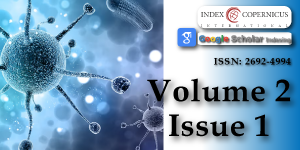Unveiling the gut virome in human health and diseases
Main Article Content
Article Details
Copyright (c) 2018 Zuo T.

This work is licensed under a Creative Commons Attribution 4.0 International License.
Virgin HW. The Virome in Mammalian Physiology and Disease. Cell. 2014; 157: 142-150. Ref.: https://goo.gl/YRtWsi
Carding SR, Davis N, Hoyles L. Review article: the human intestinal virome in health and disease. Aliment Pharmacol Ther. 2017; 46: 800-815. Ref.: https://goo.gl/k1dtxk
Ogilvie LA, Jones BV. The human gut virome: a multifaceted majority. Frontiers in Microbiology. 2015; 6: 918. Ref.: https://goo.gl/6imc97
Lecuit M, Eloit M. The human virome: new tools and concepts. Trends in Microbiology. 2013; 21: 510-515. Ref.: https://goo.gl/jf55PZ
Yang JY, Min-Soo Kim, Eugene Kim, JH Cheon, Yong-Soo Lee, et al. Enteric Viruses Ameliorate Gut Inflammation via Toll-like Receptor 3 and Toll-like Receptor 7-Mediated Interferon-beta Production. Immunity. 2016; 44: 889-900. Ref.: https://goo.gl/k5iWbW
Kernbauer E, Ding Y, Cadwell K. An enteric virus can replace the beneficial function of commensal bacteria. Nature. 2014; 516: 94-98. Ref.: https://goo.gl/kXfpXS
Duerkop BA, Hooper LV. Resident viruses and their interactions with the immune system. Nature Immunology. 2013; 14: 654-659. Ref.: https://goo.gl/H9DVVk
Minot S, Alexandra Bryson, Christel Chehoud, Gary D Wu, James D Lewis, et al. Rapid evolution of the human gut virome. Proceedings of the National Academy of Sciences of the United States of America. 2013; 110: 12450-12455. Ref.: https://goo.gl/JcxFHs
Minot S, Grunberg S, Wu GD, Lewis JD, Bushman FD. Hypervariable loci in the human gut virome. Proceedings of the National Academy of Sciences of the United States of America. 2012; 109: 3962-3966. Ref.: https://goo.gl/jCKA5j
Alejandro Reyes, Matthew Haynes, Nicole Hanson, Florent E Angly, Andrew C Heath, et al. Viruses in the faecal microbiota of monozygotic twins and their mothers. Nature. 2010; 466: 334-338. Ref.: https://goo.gl/Pzwc5G
Alison S Waller, Takuji Yamada, David M Kristensen, Jens Roat Kultima, Shinichi Sunagawa, et al. Classification and quantification of bacteriophage taxa in human gut metagenomes. Isme Journal. 2014; 8: 1391-1402. Ref.: https://goo.gl/pB4BUU
Jeremy J Barra, Rita Auroa, Mike Furlana, Katrine L Whitesona, Marcella L Erb, et al. Bacteriophage adhering to mucus provide a non-host-derived immunity. Proceedings of the National Academy of Sciences of the United States of America. 2013; 110: 10771-10776. Ref.: https://goo.gl/jjGzqY
Tao Zuo, Sunny H Wong, Long Yan K Lam, Rashid Lui, Kitty Cheung, et al. Bacteriophage Transfer during Fecal Microbiota Transplantation Is Associated with Treatment Response in Clostridium Difficile Infection. Gastroenterology. 2017. 152: 140-141. Ref.: https://goo.gl/UBx9w8
Torres-Barceló C, Hochberg ME. Evolutionary rationale for phages as complements of antibiotics. Trends in microbiology. 2016; 24: 249-256. Ref.: https://goo.gl/XDeVVo
Jason M Norman, Scott A Handley, Megan T Baldridge, Lindsay Droit, Catherine Y Liu, et al. Disease-Specific Alterations in the Enteric Virome in Inflammatory Bowel Disease. Cell. 2015; 160: 447-460. Ref.: https://goo.gl/nkvXH3
Tao Zuo, Sunny H Wong, Kelvin Lam, Rashid Lui, Kitty Cheung, et al. Bacteriophage transfer during faecal microbiota transplantation in Clostridium difficile infection is associated with treatment outcome. Gut microbiota. 2017. Ref.: https://goo.gl/HwGQcN
Brussow H, Canchaya C, Hardt WD. Phages and the evolution of bacterial pathogens: From genomic rearrangements to lysogenic conversion. Microbiology and Molecular Biology Reviews. 2004; 68: 560-602. Ref.: https://goo.gl/bKXZ7r
Reyes A, Wu M, Mc Nulty NP, Rohwer FL, Gordon JI. Gnotobiotic mouse model of phage-bacterial host dynamics in the human gut. Proceedings of the National Academy of Sciences of the United States of America. 2013; 110: 20236-20241. Ref.: https://goo.gl/oNsj8Z
Zhang YF, LeJeune JT. Transduction of bla(CMY-2), tet(A), and tet(B) from Salmonella enterica subspecies enterica serovar Heidelberg to S-Typhimurium. Veterinary Microbiology. 2008; 129: 418-425. Ref.: https://goo.gl/7NRAUM
Elisa Maiques, Carles Úbeda, Susana Campoy, Noelia Salvador, Íñigo Lasa, et al. beta-lactam antibiotics induce the SOS response and horizontal transfer of virulence factors in Staphylococcus aureus. Journal of Bacteriology. 2006; 188: 2726-2729. Ref.: https://goo.gl/5SgY4m
Kim MS, Bae JW. Spatial disturbances in altered mucosal and luminal gut viromes of diet-induced obese mice. Environmental Microbiology. 2016; 18: 1498-1510. Ref.: https://goo.gl/xFtXJB
Samuel Minot, Rohini Sinha, Jun Chen, Hongzhe Li, Sue A Keilbaugh, et al. The human gut virome: Inter-individual variation and dynamic response to diet. Genome Research. 2011; 21: 1616-1625. Ref.: https://goo.gl/kyvFBW
Efrem S Lim, Yanjiao Zhou, Guoyan Zhao, Irma K Bauer, Lindsay Droit, et al. Early life dynamics of the human gut virome and bacterial microbiome in infants. Nature Medicine. 2015; 21: 1228-1234. Ref.: https://goo.gl/g6enGj

